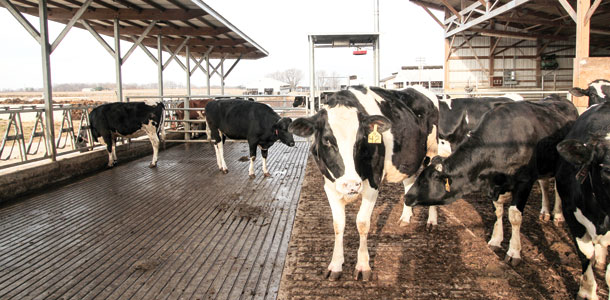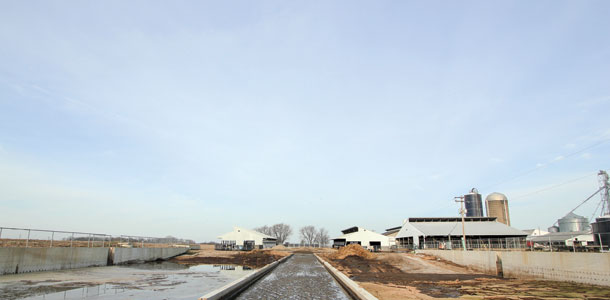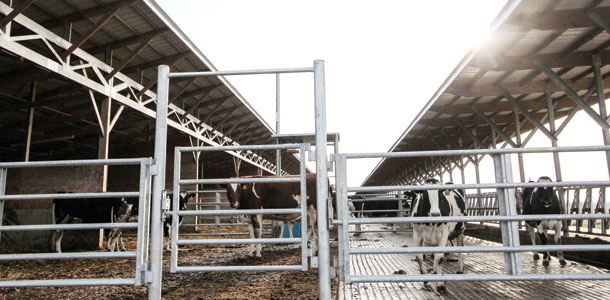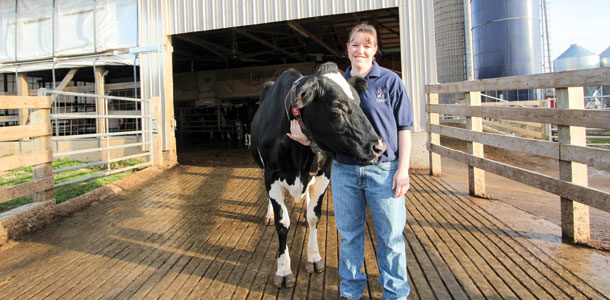The heifer facility at Elm Farms Inc. is a little over a year old, and Michelle Hasheider-Burianek loves it. She and her father, Norbert Hasheider, operate the third-generation dairy farm, which is home to 130 registered Holstein cows including seven scored Excellent in their robotic dairy setup.
They raise the heifers and steers from both the dairy herd and a beef herd as part of the multi-family farm producing crops, beef, pork and (of course) milk in Washington County, southern Illinois.
See more of Elm Farms' new heifer facility in the related slideshow.
“Our main criteria for the new heifer facility was to catch all the manure and cover the feed lane to meet total containment requirements. We used to drylot the dairy and beef heifers, but the EPA is requiring more of us here to show we are collecting everything,” Michelle explains. “We visited some facilities and saw something similar, but we wanted pens that were deeper, longer and wider.”
They also wanted it tall enough to come in with a big blade to drag off the bedded packs in the back half of each pen right into the adjacent manure pit.
While it’s tricky to give cattle “outdoor time” in a total containment system, Michelle is a big believer in space, exercise and fresh air.
 “Cattle, especially calves, crave sunshine. But to catch all the wastewater, we are putting more of our operation under roofs,” she says, explaining how they still carve out open traffic areas, where the flush system moves waste to the dairy’s multi-stage manure system comprised of a sand-settling lane, manure pit and two-stage lagoon that recycles water for the flush system and crop irrigation – so that only the dry manure is hauled to fields. Sand is recycled in a three-pile system and tested before being re-used as cow bedding.
“Cattle, especially calves, crave sunshine. But to catch all the wastewater, we are putting more of our operation under roofs,” she says, explaining how they still carve out open traffic areas, where the flush system moves waste to the dairy’s multi-stage manure system comprised of a sand-settling lane, manure pit and two-stage lagoon that recycles water for the flush system and crop irrigation – so that only the dry manure is hauled to fields. Sand is recycled in a three-pile system and tested before being re-used as cow bedding.
“The cows come and go as they please,” Norbert adds.
When Elm Farms went robotic three years ago, they created a grooved and flushable concrete cow lane for traffic to and from the existing freestall barns and the facility that now houses two robots with the cow walk-up on one side and office and equipment access on the other.
On one end of the manure management system, the sand-bedded freestall barns and cow lanes are flushed with recycled water every six hours. Situated on the opposite end of the manure storage is the new heifer facility, which has its own tank of recycled water to flush the herd alley at the front.
“One person can come in and easily pen the heifers to the front with the double-gate system and then drag the bedded area at the back of the pens and dump directly into the manure pit,” Michelle relates.

By grooving the concrete through the entire facility, the combination of small grooves under the bedding and the gentle slope in the concrete help the moisture settle out of the bedding and into the crevices to become part of what is flushed throughout the day from the herd alley at the front.
Not only is everything contained, but the bedding also stays drier, which is nice for the cattle and for cleanout. They start each new pen group by bedding the back half with a good two to three round bales of straw and manage heifer hygiene and comfort with additional bedding and cleanout as needed.
The integrated manure management system gives Elm Farms more than one year of storage. Fields are dragline-irrigated with injection, and solid manure is “knifed in,” Michelle explains.
The 12-pen heifer barn is situated with the sun to the south. The solid walls between the pens on just the back half of the pens cut down on the amount of direct wind blowing on the cattle, while the open front, sides and center traffic area allow for good ventilation.
Each pen is double-gated so heifers can be locked to the front when moving and working with the animals or to the back when cleaning the bedded pack in each pen.
 “The double gates make it so it’s a one-person job,” Michelle explains. “Everything is bred A.I. here, and we have overhead transponder readers that send us the heat notifications as they monitor both activity and rumination.”
“The double gates make it so it’s a one-person job,” Michelle explains. “Everything is bred A.I. here, and we have overhead transponder readers that send us the heat notifications as they monitor both activity and rumination.”
Dairying is a seven-days-a-week job and brings with it the added documentation and stress of increased regulation, but the Hasheiders take it in stride because they are passionate about the land and the animals. In fact, as committed stewards of the land, they’ve set aside approximately 500 acres for wildlife.
“It is a constant thing to keep improving upon everything we have. We stay with it because these cattle are like family,” Michelle explains.
She could have gone many directions with her career but chose to come home to the farm and the cows. “I love being outside, and I love the dairy farm, the cattle, the people,” she says. “Farmers are full-hearted, hard-working people. I wouldn’t change what I’m doing for anything.” PD
Sherry Bunting is a freelance writer based in East Earl, Pennsylvania.
PHOTOS
PHOTO 1: Pictured with Rory – the special “agvocating cow” in the herd, Michelle Hasheider-Burianek is a busy lady with two young daughters, Teagan and Nyelle, and coaching her alma mater’s high school girls basketball team, where she once earned her way to the Illinois Basketball Hall Of Fame. Playing for the University of Colorado Buffaloes, while earning her animal science degree, is where Michelle met husband Jason Burianek, a football player who teaches and coaches today at Missouri Baptist University.
PHOTO 2: Transponder readers – located in the center traffic alley between the bedded pack and the feed lane and headlocks of each pen – monitor activity and rumination to notify Michelle of heats.
PHOTO 3: Viewed from the new heifer facility on the opposite end of the sand lane (center), manure pit (right) and two-stage lagoon (left), are the milk cow buildings in this open yet totally contained manure management setup.
PHOTO 4: The heifer facility is divided into 12 pens with the feed lane in front and bedded packs in back under separate roofs to keep rainwater out, while the herd traffic alley is open and flushes to the adjacent manure storage throughout the day.Photos by Sherry Bunting.







